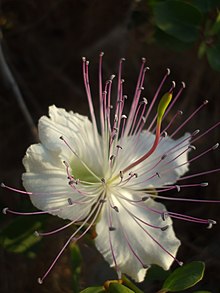Gynophore


In botany, an elongated internode in the flower between the male sexual organs ( Androeceum ) and the female sexual organs ( Gynoeceum ) is called a gynophor (from the Greek gynē , genitive gynaikos = woman, Greek -phoros = -bearing) .
The earliest evidence for the word is the book Élements de physiologie végétable et de botanique by CFB de Mirbel, published in 1815 .
It forms an extension of the floral axis between Gynoeceum and perianth , it is also called punch-holder or ovary carrier designated. The gynophore is pronounced , for example, in some species of the caper family . The sequence of the flower organs, starting from the outside, reads the perianth - Androeceum - Gynoeceum. If instead of the internode between Androeceum and Gynoeceum, the one between the flower envelope and Androeceum as well as the Gynoeceum is stretched, one speaks of an androgynophore . A so-called anthophore is also possible , which is formed between the sepals and the other flower organs in the form of a flower-bearing stalk, and separates both parts, as in the ciliate herbs ( Silene ) in the carnation family .
A Gynophor is not the same as a pedicled ovary , a prop foot or a Karpophor , the fruit holder, here form other basalt ropes on the ovary a stem or an extension, for the most part carpel derived. However, the term is often used synonymously.
With a cyathium , a reduced and complex inflorescence that appears like a single flower, the middle and raised female flower can also be viewed as standing on a gynophore.
Individual evidence
- ↑ Gynophor in the Lexicon of Biology.
- ↑ Schütt, Schuck, Stimm: Lexicon of tree and shrub species . Nikol, Hamburg 2002, ISBN 3-933203-53-8 , pp. 204 .
- ↑ a b Gerhard Wagenitz : Dictionary of Botany. Morphology, anatomy, taxonomy, evolution. 2nd, extended edition, Nikol, Hamburg 2008, ISBN 978-3-937872-94-0 , p. 134.
- ↑ Fruit bearers in the Lexicon of Biology.
- ↑ Manfred Eichhorn: Dictionary of Biology English. Volume 1, Langenscheidt, Routledge, 1999, ISBN 0-415-17129-6 , p. 357.
- ↑ Andreas Bresinsky , Christian Körner , Joachim W. Kadereit a . a .: Strasburg textbook of botany . 36th edition. Spektrum Akademischer Verlag, Heidelberg 2008, ISBN 3-8274-1455-5 , p. 817 .


